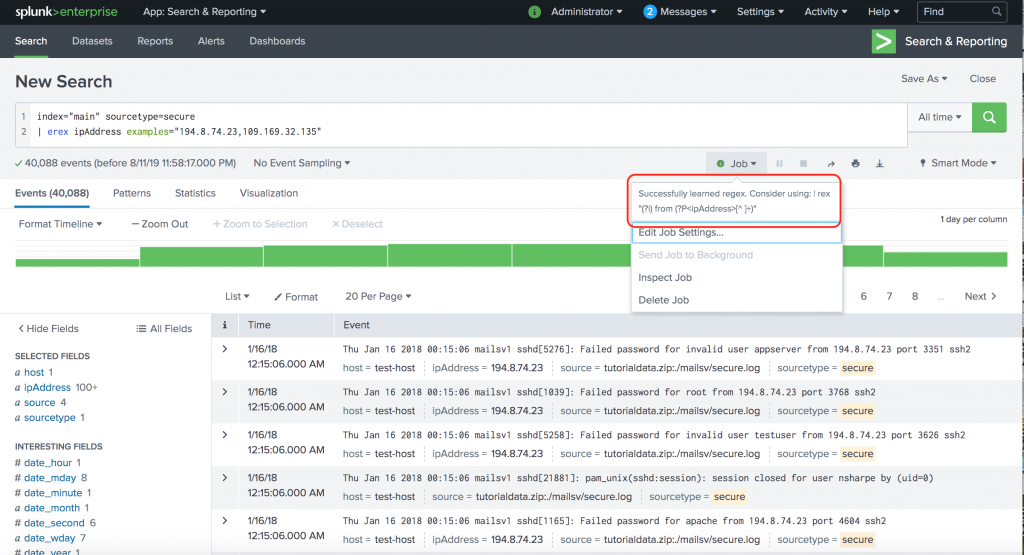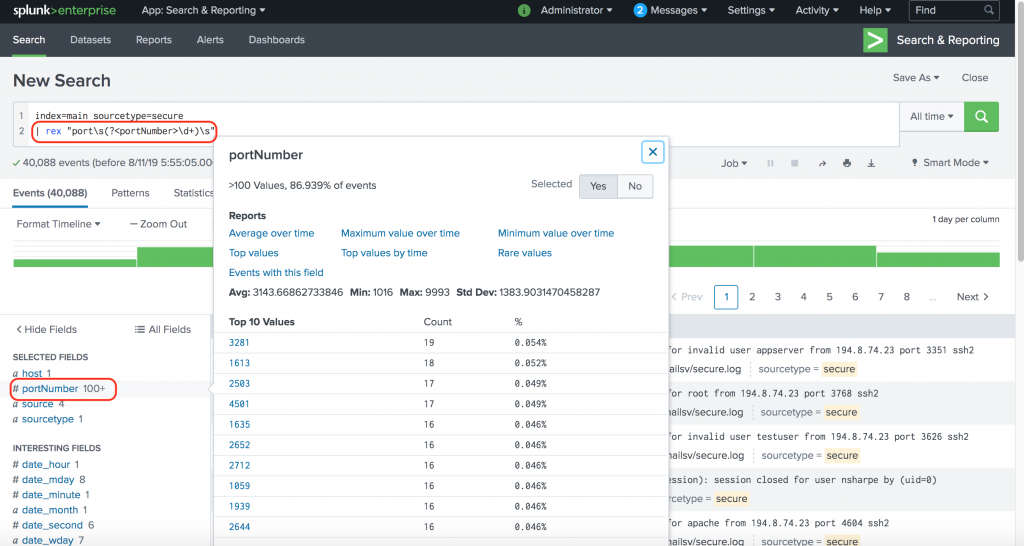
An example of finding deprecation warnings in the logs of an app would be: You can filter your data using regular expressions and the Splunk keywords rex and regex. In this example, index=* OR index=_* sourcetype=generic_logs is the data body on which Splunk performs search Cybersecurity, and then head 10000 causes Splunk to show only the first (up to) 10,000 entries. Index=* OR index=_* sourcetype=generic_logs | search Cybersecurity | head 10000


Here is an example of a longer SPL search string: This syntax also applies to the arguments following the search keyword. (Optional) Search data sources whose type is datasource01.
SPLUNK REX FIELD RAW EXAMPLE ARCHIVE
Show all Fatal entries from /var/log/syslog belonging to the blog host myblogĪccess the index called myIndex and text matching password.Īccess the data archive called test_data.zip and parse all its entries (*). Host="myblog" source="/var/log/syslog" Fatal Index="customer_feedback" _raw="*excellent*"Īll entries whose text contains the keyword “excellent” in the indexed data set customer_feedback
SPLUNK REX FIELD RAW EXAMPLE CODE
Source="bigdata.rar:*" index="data_tutorial" Code=REDĪll entries where the field Code has value RED in the archive bigdata.rar indexed as data_tutorial Source="/var/log/myapp/access.log" status=404Īll lines where the field status has value 404 from the file /var/log/myapp/access.log Index=cybersecurity hacker SPL search termsįind the word “Cybersecurity” irrespective of capitalizationįind those three words in any order irrespective of capitalizationįind the exact phrase with the given special characters, irrespective of capitalization This is the shorthand query to find the word hacker in an index called cybersecurity: For comparing two different fields.īegin by specifying the data using the parameter index, the equal sign =, and the data index of your choice: index=index_of_choice.Ĭomplex queries involve the pipe character |, which feeds the output of the previous query into the next. Similar to stats but used on metrics instead of eventsĭisplays the most/least common values of a fieldįilters search results using eval expressions. Provides statistics, grouped optionally by fields Sorts the search results by the specified fields X Use wildcards (*) to specify multiple fields.Įxtract fields according to specified regular expression(s)įilters results to those that match the search expression Returns the first/last N results, where N is a positive integerĪdds field values from an external source Returns results in a tabular output for (time-series) chartingĬalculates an expression (see Calculations) Note the decreasing number of results below: Finding entries without IPv4 address on sample data Common Search Commands Command It is a process of narrowing the data down to your focus.

Search commands help filter unwanted events, extract additional information, calculate values, transform data, and statistically analyze the indexed data.

Here is an example of an event in a web activity log: It can be a text document, configuration file, or entire stack trace. Unless you’re joining two explicit Boolean expressions, omit the AND operator because Splunk assumes the space between any two search terms to be AND.īasic Search offers a shorthand for simple keyword searches in a body of indexed data myIndex without further processing:Īn event is an entry of data representing a set of values associated with a timestamp. Splunk uses what’s called Search Processing Language (SPL), which consists of keywords, quoted phrases, Boolean expressions, wildcards (*), parameter/value pairs, and comparison expressions. The Search Head is for searching, analyzing, visualizing, and summarizing your data.The Forwarder (optional) sends data from a source.The Indexer parses and indexes data added to Splunk.Splunk contains three processing components: Splunk Enterprise search results on sample data With Splunk, not only is it easier for users to excavate and analyze machine-generated data, but it also visualizes and creates reports on such data. The Internet of Things (IoT) and Internet of Bodies (IoB) generate much data, and searching for a needle of datum in such a haystack can be daunting.


 0 kommentar(er)
0 kommentar(er)
